Fabrication and Characterization of a Marine Wet Solar Cell with Titanium Dioxide and Copper Oxides Electrodes
Abstract
1. Introduction
1.1. Background
1.2. Titanium Dioxide Photocatalyst
1.3. Copper Oxides Photocatalysts
1.4. Study of the Marine Wet Solar Cell
2. Results
2.1. Photocatalytic Properties of Each Electrode
2.2. X-ray Diffraction Analysis of Copper oxides Electrode
2.3. Power Density–Cell Voltage Characteristics of Each Cell
2.4. Electrochemical Properties of Electrodes by EIS Analysis
3. Discussions
4. Experimental
4.1. Fabrication of the Marine Wet Solar Cell
4.1.1. Preparation of Titanium Dioxide Electrode
4.1.2. Preparation of Copper Oxides Electrode
4.1.3. Fabrication of the Cell
- The first was a separated TiO2–copper oxides cell. In the separated cell, the two electrodes were insulated with epoxy resin separately, and were measured 10 cm apart in artificial seawater;
- The second cell was a combined TiO2–copper oxides cell. In this combined cell, the TiO2 electrode and copper oxides electrode were connected using a silicon binder, which acted as an insulator between the electrodes. The cell was covered with epoxy resin in preparation for the measurement;
- In the third type of cell, the passivated stainless steel substrate was used as the cathodic electrode coupled with the TiO2 electrode (TiO2–S.S. cell);
- The last cell was the TiO2 electrode vs. platinum counter-electrode (TiO2–Pt cell). A simple illustration regarding the preparation procedure of the electrodes is shown in Figure 7, along with the image of the prepared combined cell.
4.2. Electrochemical Measurement
4.3. XRD Analysis of the Electrodes
5. Conclusions and Perspectives
- The measurement of each electrode showed that their photopotential values remained stable, and close to the standard potential of each electrode;
- The cell voltage of the TiO2–Cu oxides cell was stable over 24 h of measurement, with a few drops in the early hours. The factors affecting that drop were revealed. Some residual Cu2O that remained in the Cu oxides electrode after heat treatment underwent oxidation in the seawater under irradiation. This oxidation led to lower p-type semiconductor photocatalytic activity of the Cu oxides electrode;
- We have achieved a power profile of the combined TiO2–Cu oxides cell in which the maximum power density was two-thirds of that of the TiO2–platinum cell. This can support the replacement of platinum counter-electrodes with copper oxides electrodes in terms of cost-to-energy-conversion efficiency;
- From the EIS measurements, the impedance values for the charge-transfer resistance of the semiconductor electrode/electrolyte were evaluated by constructing a simple equivalent circuit. From this, we can consider the preparation techniques and the materials to reduce the resistance of the electrode.
Author Contributions
Funding
Data Availability Statement
Acknowledgments
Conflicts of Interest
References
- Perera, H.D.M.R. Designing of 3MW Floating Photovoltaic Power System and its Benefits over Other PV Technologies. Int. J. Adv. Sci. Res. Eng. 2020, 6, 37–48. [Google Scholar] [CrossRef]
- Solomin, E.; Sirotkin, E.; Cuce, E.; Selvanathan, S.P.; Kumarasamy, S. Hybrid Floating Solar Plant Designs: A Review. Energies 2021, 14, 2751. [Google Scholar] [CrossRef]
- Sreenath, S.; Sudhakar, K.; Yusop, A.F.; Solomin, E.; Kirpichnikova, I.M. Solar PV Energy System in Malaysian Airport: Glare Analysis, General Design and Performance Assessment. Energy Rep. 2020, 6, 698–712. [Google Scholar] [CrossRef]
- Bakranov, N.; Zhabaikhanov, A.; Kudaibergenov, S.; Ibraev, N. Decoration of Wide Bandgap Semiconducting Materials for Enhancing Photoelectrochemical Efficiency of PEC Systems. In Journal of Physics: Conference Series; IOP Publishing: Bristol, UK, 2018; p. 012028. [Google Scholar] [CrossRef]
- Fujishima, A.; Honda, K. Electrochemical Photolysis of Water at a Semiconductor Electrode. Nature 1972, 238, 37–38. [Google Scholar] [CrossRef] [PubMed]
- O’Regan, B.; Grätzel, M. A Low-Cost, High-Efficiency Solar Cell Based on Dye-Sensitized Colloidal TiO2 Films. Nature 1991, 353, 737–740. [Google Scholar] [CrossRef]
- Fahmi, A.; Minot, C.; Silvi, B.; Causa, M. Theoretical Analysis of the Structures of Titanium Dioxide Crystals. Phys. Rev. B 1993, 47, 11717. [Google Scholar] [CrossRef]
- Ding, X.Z.; Liu, X.H.; He, Y.Z. Grain Size Dependence of Anatase-to-Rutile Structural Transformation in Gel-Derived Nanocrystalline Titania Powders. J. Mat. Sci. Let. 1996, 15, 1789–1791. [Google Scholar] [CrossRef]
- Smith, S.J.; Stevens, R.; Liu, S.; Li, G.; Navrotsky, A.; Boerio-Goates, J.; Woodfield, B.F. Heat Capacities and Thermodynamic Functions of TiO2 Anatase and Rutile: Analysis of Phase Stability. Amer. Miner. 2009, 94, 236–246. [Google Scholar] [CrossRef]
- Ghosh, T.B.; Dhabal, S.; Datta, A.K. On Crystallite Size Dependence of Phase Stability of Nanocrystalline TiO2. J. Appl. Phys. 2003, 94, 4577. [Google Scholar] [CrossRef]
- Beltran, A.; Gracia, L.; Andres, J. Density Functional Theory Study of the Brookite Surfaces and Phase Transitions between Natural Titania Polymorphs. J. Phys. Chem. B 2006, 110, 23417–23423. [Google Scholar] [CrossRef]
- El Goresy, A.; Chen, M.; Dubrovinsky, L.S.; Gillet, P.; Graup, G. An Ultradense Polymorph of Rutile with Seven-Coordinated Titanium from the Ries Crater. Science 2001, 293, 1467–1470. [Google Scholar] [CrossRef] [PubMed]
- Muscat, J.; Swamy, V.; Harrison, N.M. First-Principles Calculations of The Phase Stability of TiO2. Phys. Rev. B 2002, 65, 224112. [Google Scholar] [CrossRef]
- Reyes, C.D.; Rodriguez, G.G.; Espinosa, P.M.E.; Cab, C.; de Coss, R.; Oskam, G. Phase-Pure TiO2 Nanoparticles: Anatase, Brookite and Rutile. Nanotechnology 2008, 19, 145605. [Google Scholar] [CrossRef]
- Kalyanasundaram, K.; Bertoz, M.; Bisquert, J.; Angelis, F.D.; Desilvestro, H.; Santiago, F.F.; Fantacci, S.; Hagfeldt, I.S.; Jiang, K.J.; Kamat, P.V.; et al. Dye-Sensitized Solar Cell, 1st ed.; CRC Press, Taylor and Francis Group: Boca Raton, FL, USA, 2010; pp. 1–76. [Google Scholar]
- Hanaor, D.A.H.; Sorrell, C.C. Review of The Anatase to Rutile Phase Transformation. J. Mater. Sci. 2011, 46, 855–874. [Google Scholar] [CrossRef]
- Wold, A. Photocatalytic Properties of Titanium Dioxide (TiO2). Chem. Mater. 1993, 5, 280–283. [Google Scholar] [CrossRef]
- Gratzel, M. Solar Energy Conversion by Dye-Sensitized Photovoltaic Cells. Inorg. Chem. 2005, 44, 6841–6851. [Google Scholar] [CrossRef]
- Bessekhouad, Y.; Robert, D.; Weber, J.V. Preparation of TiO2 Nanoparticles by Sol-Gel Route. Int. J. Photoenergy 2003, 5, 153–158. [Google Scholar] [CrossRef]
- Baram, N.; Starosvetsky, D.; Starosvetsky, J.; Epshtein, M.; Armon, R.; Ein-Eli, Y. Enhanced Photo-Efficiency of Immobilized TiO2 Catalyst Via Intense Anodic Bias. Electrochem. Commun. 2007, 9, 1684–1688. [Google Scholar] [CrossRef]
- Mitoraj, D.; Janczyk, A.; Strus, M.; Kisch, H.; Stochel, G.; Heczko, P.B.; Macyk, W. Visible Light Inactivation of Bacteria and Fungi by Modified Titanium Dioxide. Photochem. Photobiol. Sci. 2007, 6, 642. [Google Scholar] [CrossRef]
- Kisch, H.; Burgeth, G.; Macyk, W. Visible Light Photocatalysis by A Titania Transition Metal Complex. Adv. Inorg. Chem. 2004, 56, 241–259. [Google Scholar] [CrossRef]
- Fujino, T.; Matzuda, T. Synthetic Process of Titanium Dioxide Coating on Aluminum by Chemical Conversion Method. Mater. Trans. 2006, 47, 849–853. [Google Scholar] [CrossRef][Green Version]
- León, A.; Reuquen, P.; Garín, C.; Segura, R.; Vargas, P.; Zapata, P.; Orihuela, P.A. FTIR and Raman Characterization of TiO2 Nanoparticles Coated with Polyethylene Glycol as Carrier for 2-Methoxyestradiol. Appl. Sci. 2017, 7, 49. [Google Scholar] [CrossRef]
- Burns, G.P. Titanium Dioxide Dielectric Films Formed by Rapid Thermal Oxidation. J. Appl. Phys. 1989, 65, 2095. [Google Scholar] [CrossRef]
- Mittiga, A.; Salza, E.; Sarto, F.; Tucci, M.; Vasanthi, R. Heterojunction Solar Cell with 2% Efficiency Based on a Cu2O Substrate. Appl. Phys. Lett. 2006, 88, 163502. [Google Scholar] [CrossRef]
- Minami, T.; Miyata, T.; Ihara, K.; Minamino, Y.; Tsukada, S. Effect of ZnO Film Deposition Methods on the Photovoltaic Properties of ZnO–Cu2O Heterojunction Devices. Thin Solid Films 2006, 494, 47–52. [Google Scholar] [CrossRef]
- Wong, L.M.; Chiam, S.Y.; Huang, J.Q.; Wang, S.J.; Pan, J.S.; Chim, W.K. Growth of Cu2O on Ga-doped ZnO and Their Interface Energy Alignment for Thin Film Solar Cells. J. Appl. Phys. 2010, 108, 033702. [Google Scholar] [CrossRef]
- Raizada, P.; Sudhaik, A.; Patial, S.; Hasija, V.; Khan, A.A.P.; Singh, P.; Gautam, S.; Kaur, M.; Nguyen, V.H. Engineering Nanostructures of CuO-Based Photocatalysts for Water Treatment: Current Progress and Future Challenges. Arab. J. Chem. 2020, 13, 8424–8457. [Google Scholar] [CrossRef]
- Narayanan, R.; El-Sayed, M.A. Catalysis with Transition Metal Nanoparticles in Colloidal Solution: Nanoparticle Shape Dependence and Stability. J. Phys. Chem. B 2005, 109, 12663–12676. [Google Scholar] [CrossRef] [PubMed]
- Kumar, K.Y.; Muralidhara, H.B.; Nayaka, Y.A.; Hanumanthappa, H.; Veena, M.S.; Kumar, S.R. Hydrothermal Synthesis of Hierarchical Copper Oxide Nanoparticles and Its Potential Application as Adsorbent for Pb (II) with High Removal Capacity. Sep. Sci. Technol. 2014, 49, 2389–2399. [Google Scholar] [CrossRef]
- Verma, N.; Kumar, N. Synthesis and Biomedical Applications of Copper Oxide Nanoparticles: An Expanding Horizon. Biomater. Sci. Eng. 2019, 5, 1170–1188. [Google Scholar] [CrossRef]
- Pavan, M.; Ruhle, S.; Ginsburg, A.; Keller, D.A.; Barad, H.N.; Sberna, P.M.; Nunes, D.; Martins, R.; Anderson, A.Y.; Zaban, A.; et al. TiO2/Cu2O All-Oxide Heterojunction Solar Cells Produced by Spray Pyrolysis. Sol. Energy Mater. Sol. Cells 2014, 132, 549–556. [Google Scholar] [CrossRef]
- Armelao, L.; Barreca, D.; Bertapelle, M.; Bottaro, G.; Sada, C.; Tondello, E. A Sol–Gel Approach to Nanophasic Copper Oxide Thin Films. Thin Solid Films 2003, 442, 48–52. [Google Scholar] [CrossRef]
- Kosugi, T.; Kaneko, S. Novel Spray-Pyrolysis Deposition of Cuprous Oxide Thin Films. J. Am. Ceram. Soc. 1998, 81, 3117–3124. [Google Scholar] [CrossRef]
- Heiroth, S.; Ghisleni, R.; Lippert, T.; Michler, J.; Wokaun, A. Optical and Mechanical Properties of Amorphous and Crystalline Yttria-Stabilized Zirconia Thin Films Prepared by Pulsed Laser Deposition. Acta Mater. 2011, 59, 2330–2340. [Google Scholar] [CrossRef]
- Ogale, S.B.; Bilurkar, P.G.; Mate, N.; Kanetkar, S.M. Deposition of Copper Oxide Thin Films on Different Substrates by Pulsed Excimer Laser Ablation. J Appl. Phys. 1992, 72, 3765. [Google Scholar] [CrossRef]
- Choudhary, S.; Sarma, J.V.N.; Pande, S.; Girard, S.A.; Turban, P.; Lepine, B.; Gangopadhyay, S. Oxidation Mechanism of Thin Cu Films: A Gateway Towards the Formation of Single Oxide Phase. AIP Adv. 2018, 8, 055114. [Google Scholar] [CrossRef]
- Ito, S.; Chen, P.; Comte, P.; Nazeeruddin, M.K.; Liska, P.; Pechy, P.; Gratzel, M. Fabrication of Screen-Printing Pastes from TiO2 Powders for Dye-Sensitized Solar Cells. Prog. Photovolt. Res. Appl. 2007, 15, 603–612. [Google Scholar] [CrossRef]
- Motoda, S.; Morita, M.; Tamura, S. Characteristics of Double Layered TiO2 Anode Assembling to Marine Microbial Fuel Cell. ECS Trans. 2017, 75, 133–143. [Google Scholar] [CrossRef]
- Alami, A.H.; Rajab, B.; Abed, J.; Faraj, M.; Hawili, A.A.; Alawadhi, H. Investigating Various Copper Oxides-Based Counter Electrodes for Dye Sensitized Solar Cell Applications. Energy 2019, 174, 526–533. [Google Scholar] [CrossRef]
- Shibata, M.; Sakai, Y.; Yokoyama, D. Advantages and Disadvantages of Vacuum-Deposited and Spin-Coated Amorphous Organic Semiconductor Films for Organic Light-Emitting Diodes. J. Mater. Chem 2015, 3, 11178–11191. [Google Scholar] [CrossRef]
- Morita, M.; Kishihara, K.; Motoda, S.; Koga, N.; Shinohara, T. Effect of Oxidation Temperature on Photo-Catalytic Properties of Stainless Steel Coated by Copper Oxide. ISIJ Int. 2017, 57, 1609–1616. [Google Scholar] [CrossRef]
- Raja, M.; Subha, J.; Ali, F.B.; Ryu, S.H. Synthesis of Copper Nanoparticles by Electroreduction Process. Mater. Manuf. Processes 2008, 23, 782–785. [Google Scholar] [CrossRef]
- Mehmood, U.; Aslam, H.M.Z.; Sulaiman, F.A.A.; Ahmed, A.A.; Ahmed, S.; Malik, M.I.; Younas, M. Electrochemical Impedance Spectroscopy and Photovoltaic Analyses of Dye-Sensitized Solar Cells Based on Carbon/TiO2 Composite Counter Electrode. J. Electrochem. Soc. 2016, 163, H339. [Google Scholar] [CrossRef]
- Itagaki, M.; Suzuki, S.; Shitanda, I.; Watanabe, K. Electrochemical Impedance and Complex Capacitance to Interpret Electrochemical Capacitor. Electrochemistry 2007, 75, 649–655. [Google Scholar] [CrossRef]
- Sarker, S.; Ahammad, A.J.S.; Seo, H.W.; Kim, D.M. Electrochemical Impedance Spectra of Dye-Sensitized Solar Cells: Fundamentals and Spreadsheet Calculation. Int. J. Photoenergy 2014, 2014, 851705. [Google Scholar] [CrossRef]
- Valladares, L.D.L.S.; Salinas, D.H.; Dominguez, A.B.; Najarro, D.A.; Khondaker, S.I.; Mitrelias, T.; Barnes, C.H.W.; Aguiar, J.A.; Majima, Y. Crystallization and Electrical Resistivity of Cu2O and CuO Obtained by Thermal Oxidation of Cu Thin Films on SiO2/Si Substrate. Thin Solid Films 2012, 520, 6368–6374. [Google Scholar] [CrossRef]
- Saadmim, F.; Forhad, T.; Sikder, A.; Ghann, W.; M Ali, M.M.; Sitther, V.; Ahammad, A.J.S.; Subhan, M.A.; Uddin, J. Enhancing the Performance of Dye Sensitized Solar Cells Using Silver Nanoparticles Modified Photoanode. Molecules 2020, 25, 4021. [Google Scholar] [CrossRef] [PubMed]
- Featured Products, NAS Stainless Steel Strip MFG. Co., Ltd. Available online: http://www.nas-kotai.co.jp/en/leaflet/354n.html# (accessed on 3 October 2021).
- Noh, J.S.; Laycock, N.J.; Gao, W.; Wells, D.B. Effects of Nitric Acid Passivation on the Pitting Resistance of 316 Stainless Steel. Corros. Sci. 2000, 42, 2069–2084. [Google Scholar] [CrossRef]
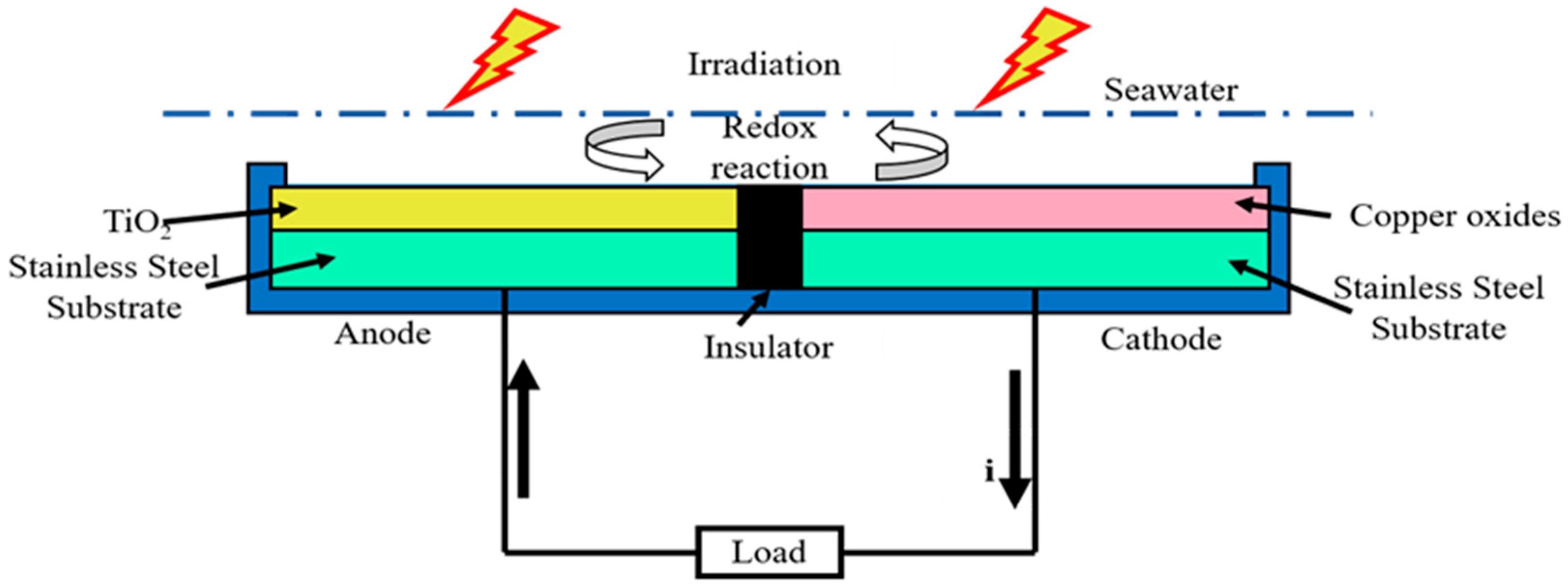

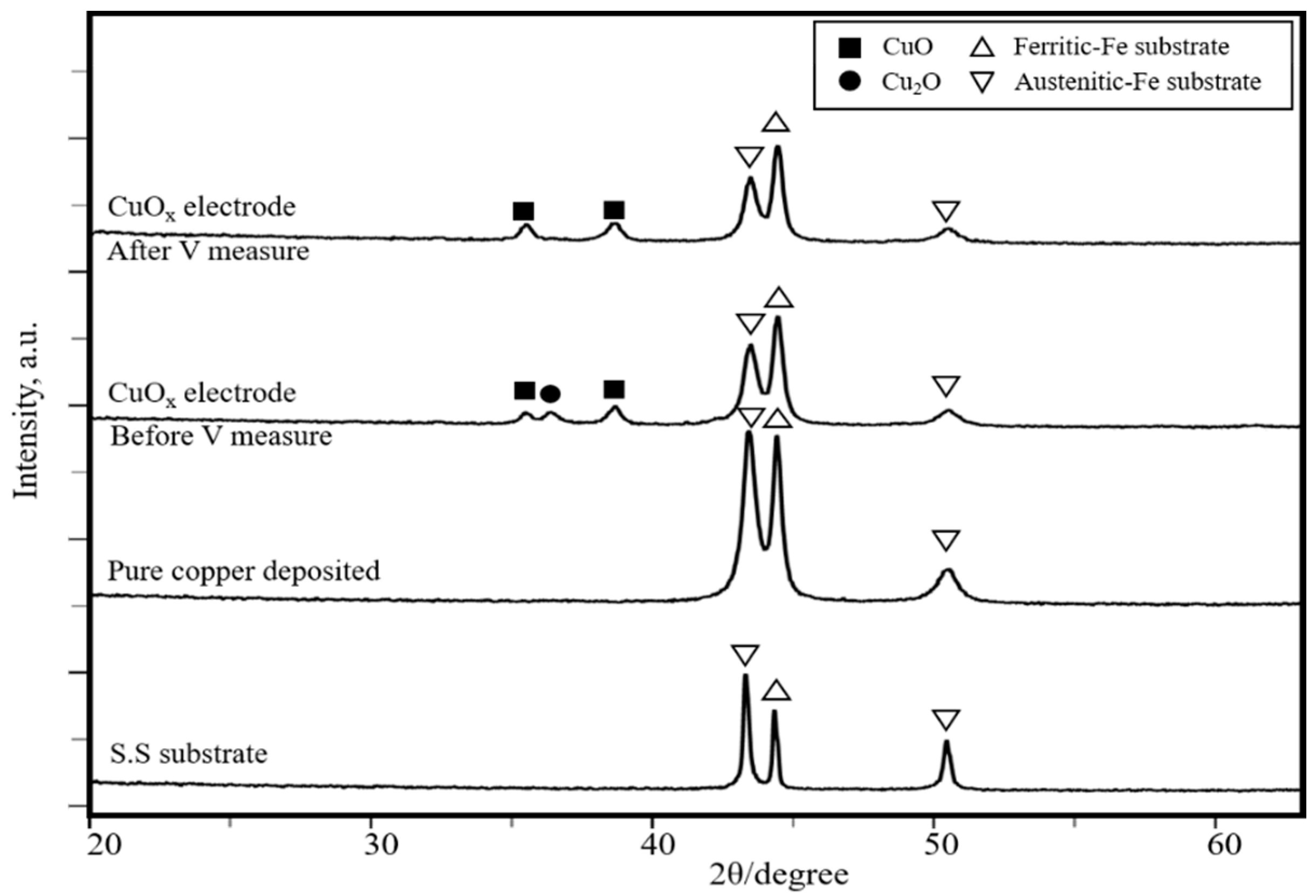
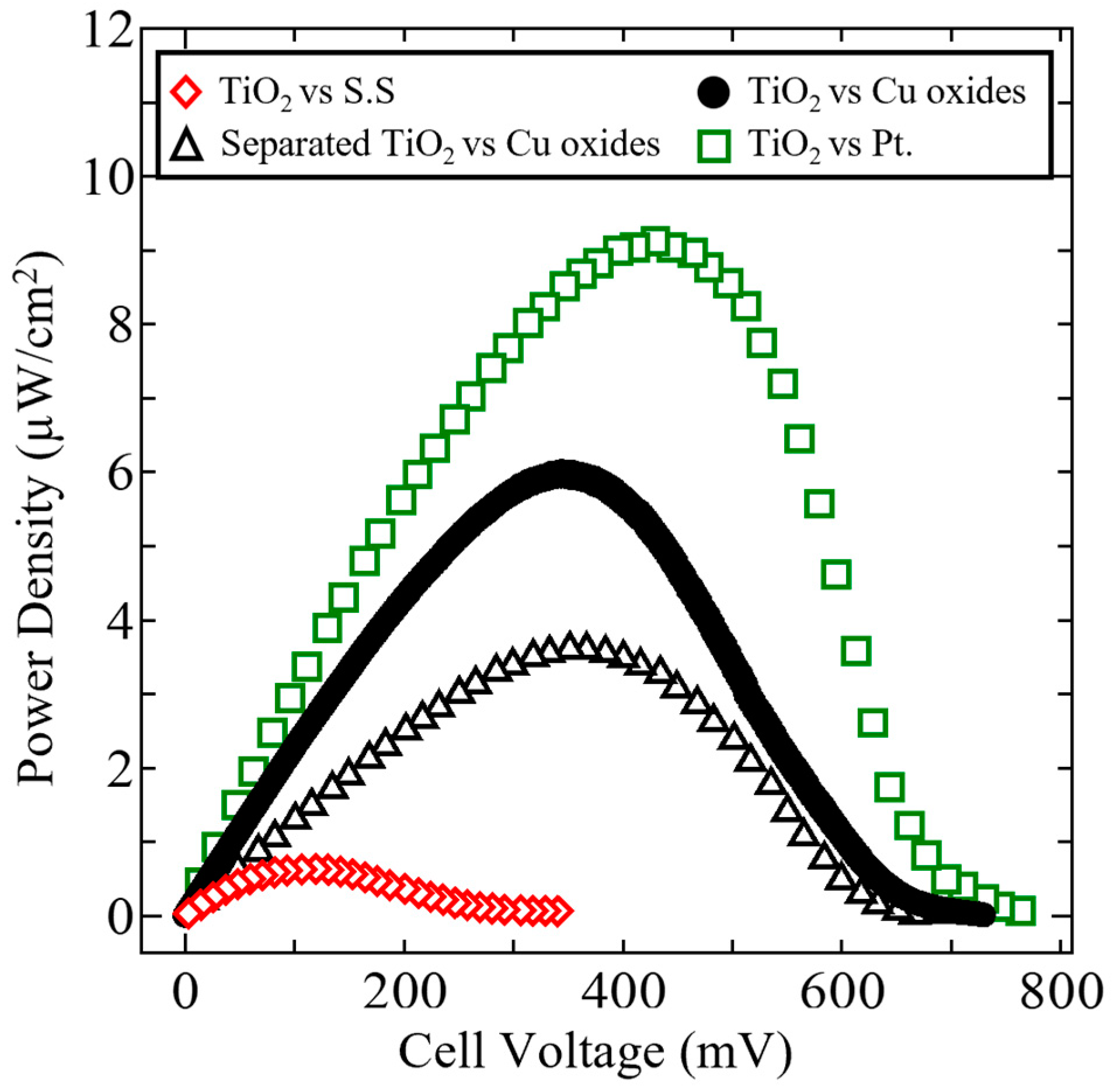
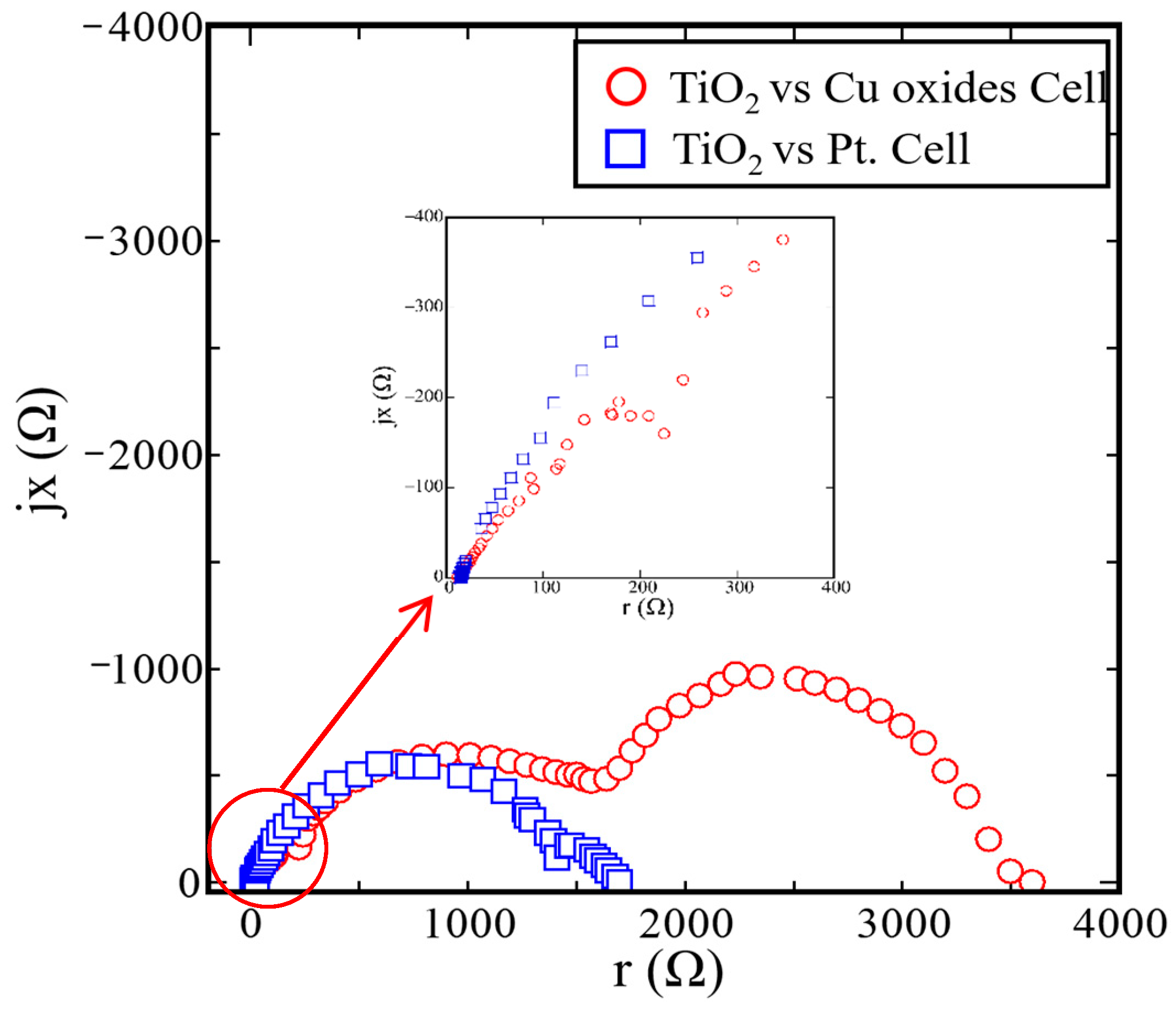


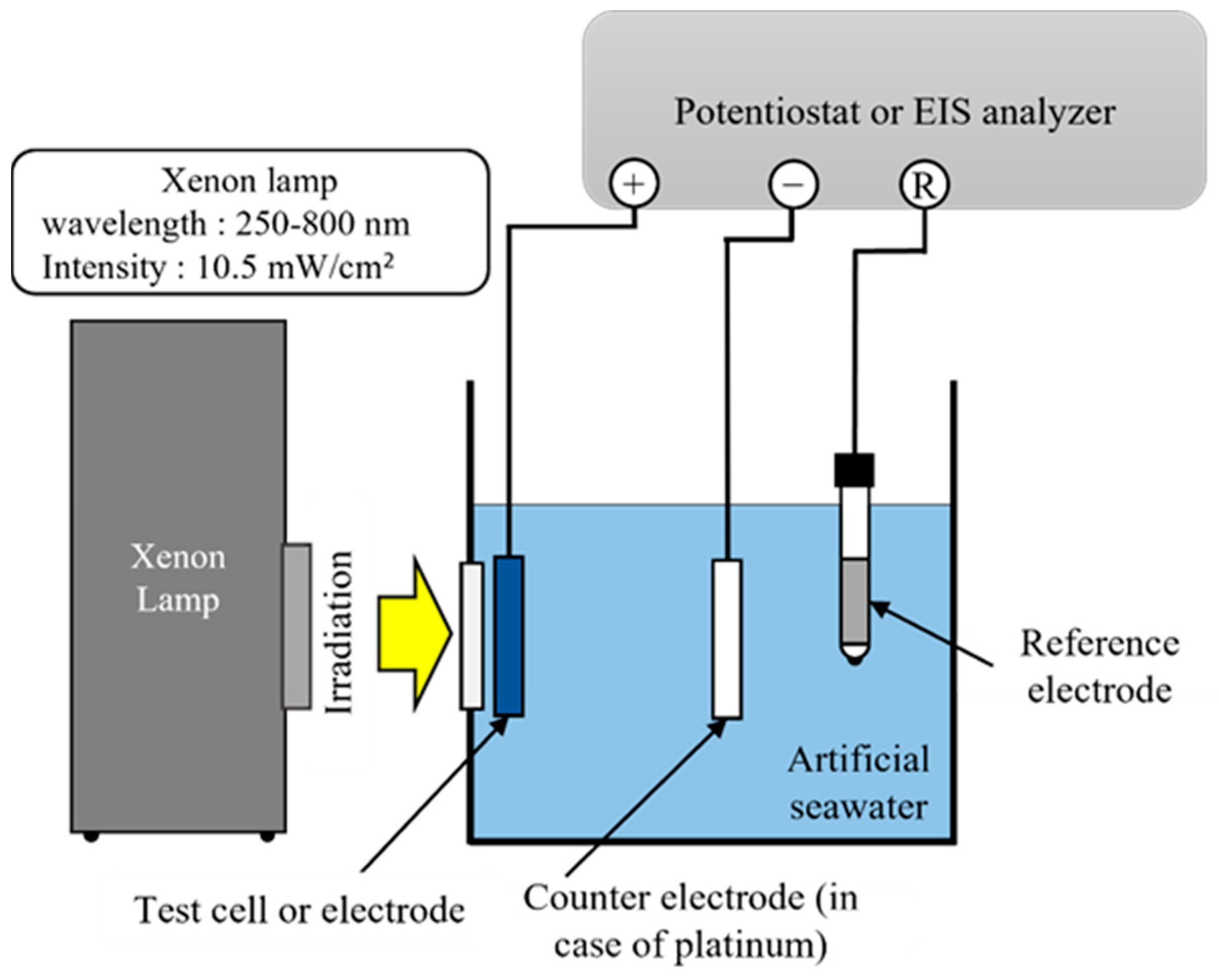
| Cells | Jsc (μA/cm2) | Voc (mV) | Pmax (μW/cm2) | FF (%) |
|---|---|---|---|---|
| Separated TiO2–Cu oxides | 17.96 | 727.4 | 4.20 | 32.15 |
| Combined TiO2–Cu oxides | 23.44 | 730.3 | 5.96 | 34.82 |
| TiO2–stainless steel | 11.20 | 561.6 | 0.64 | 10.20 |
| TiO2–platinum | 31.68 | 764.1 | 9.11 | 37.63 |
| Cells | Impedance Values | ||||||
|---|---|---|---|---|---|---|---|
| Series Resistance | RC Circuit 1 | RC Circuit 2 | RC Circuit 3 | ||||
| Rs | R1 (Ω) | C1 (mF) | R2 (Ω) | C2 (mF) | R3 (Ω) | C3 (mF) | |
| TiO2–Cu oxides | 15.26 | 156.81 | 0.01 | 1290 | 0.36 | 2180 | 5.36 |
| TiO2–platinum | 14.03 | 1330 | 1.99 | 81.91 | 0.81 | ||
| C | Si | Mn | P | Ni | Cr | Mo | W | N | Fe |
|---|---|---|---|---|---|---|---|---|---|
| 0.025 | 0.44 | 0.77 | 0.027 | 6.34 | 24.96 | 3.22 | 0.14 | 0.27 | Bal. |
| TiO2 Paste | TiO2 | C2H5OH | CH3OH | C3H7OH | Confidential | Water |
| 16 | 5–15 | 0–1 | 0–2 | 1–10 | Bal. |
Publisher’s Note: MDPI stays neutral with regard to jurisdictional claims in published maps and institutional affiliations. |
© 2022 by the authors. Licensee MDPI, Basel, Switzerland. This article is an open access article distributed under the terms and conditions of the Creative Commons Attribution (CC BY) license (https://creativecommons.org/licenses/by/4.0/).
Share and Cite
Wunn, H.N.; Motoda, S.; Morita, M. Fabrication and Characterization of a Marine Wet Solar Cell with Titanium Dioxide and Copper Oxides Electrodes. Catalysts 2022, 12, 99. https://doi.org/10.3390/catal12010099
Wunn HN, Motoda S, Morita M. Fabrication and Characterization of a Marine Wet Solar Cell with Titanium Dioxide and Copper Oxides Electrodes. Catalysts. 2022; 12(1):99. https://doi.org/10.3390/catal12010099
Chicago/Turabian StyleWunn, Htoo Nay, Shinichi Motoda, and Motoaki Morita. 2022. "Fabrication and Characterization of a Marine Wet Solar Cell with Titanium Dioxide and Copper Oxides Electrodes" Catalysts 12, no. 1: 99. https://doi.org/10.3390/catal12010099
APA StyleWunn, H. N., Motoda, S., & Morita, M. (2022). Fabrication and Characterization of a Marine Wet Solar Cell with Titanium Dioxide and Copper Oxides Electrodes. Catalysts, 12(1), 99. https://doi.org/10.3390/catal12010099






